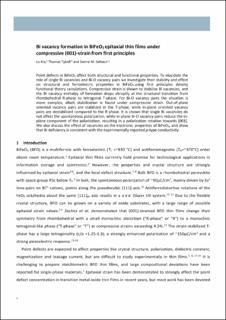| dc.contributor.author | Xia, Lu | |
| dc.contributor.author | Tybell, Thomas | |
| dc.contributor.author | Selbach, Sverre Magnus | |
| dc.date.accessioned | 2020-04-14T10:41:04Z | |
| dc.date.available | 2020-04-14T10:41:04Z | |
| dc.date.created | 2019-08-08T12:09:16Z | |
| dc.date.issued | 2019 | |
| dc.identifier.citation | Journal of Materials Chemistry C. 2019, 7 (16), 4870-4878. | en_US |
| dc.identifier.issn | 2050-7526 | |
| dc.identifier.uri | https://hdl.handle.net/11250/2650949 | |
| dc.description.abstract | Point defects in BiFeO3 affect both structural and functional properties. To elucidate the role of single Bi vacancies and Bi–O vacancy pairs we investigate their stability and effect on structural and ferroelectric properties in BiFeO3 using first principles density functional theory calculations. Compressive strain is shown to stabilize Bi vacancies, and the Bi vacancy enthalpy of formation drops abruptly at the structural transition from rhombohedral R-phase to tetragonal T-phase. For Bi–O vacancy pairs the situation is more complex, albeit stabilization is found under compressive strain. Out-of-plane oriented vacancy pairs are stabilized in the T-phase, while in-plane oriented vacancy pairs are destabilized compared to the R-phase. It is shown that single Bi vacancies do not affect the spontaneous polarization, while in-plane Bi–O vacancy pairs reduce the in-plane component of the polarization, resulting in a polarization rotation towards [001]. We also discuss the effect of vacancies on the electronic properties of BiFeO3, and show that Bi deficiency is consistent with the experimentally reported p-type conductivity. | en_US |
| dc.language.iso | eng | en_US |
| dc.publisher | Royal Society of Chemistry | en_US |
| dc.title | Bi vacancy formation in BiFeO3 epitaxial thin films under compressive (001)-strain from first principles | en_US |
| dc.type | Peer reviewed | en_US |
| dc.type | Journal article | en_US |
| dc.description.version | acceptedVersion | en_US |
| dc.source.pagenumber | 4870-4878 | en_US |
| dc.source.volume | 7 | en_US |
| dc.source.journal | Journal of Materials Chemistry C | en_US |
| dc.source.issue | 16 | en_US |
| dc.identifier.doi | 10.1039/c8tc06608f | |
| dc.identifier.cristin | 1714818 | |
| dc.relation.project | Notur/NorStore: NN9264K | en_US |
| dc.relation.project | Norges forskningsråd: 231430 | en_US |
| dc.description.localcode | © 2019. This is the authors' accepted and refereed manuscript to the article. The final authenticated version is available online at: https://doi.org/10.1039/C8TC06608F | en_US |
| cristin.unitcode | 194,66,35,0 | |
| cristin.unitcode | 194,63,35,0 | |
| cristin.unitname | Institutt for materialteknologi | |
| cristin.unitname | Institutt for elektroniske systemer | |
| cristin.ispublished | true | |
| cristin.fulltext | postprint | |
| cristin.qualitycode | 1 | |
